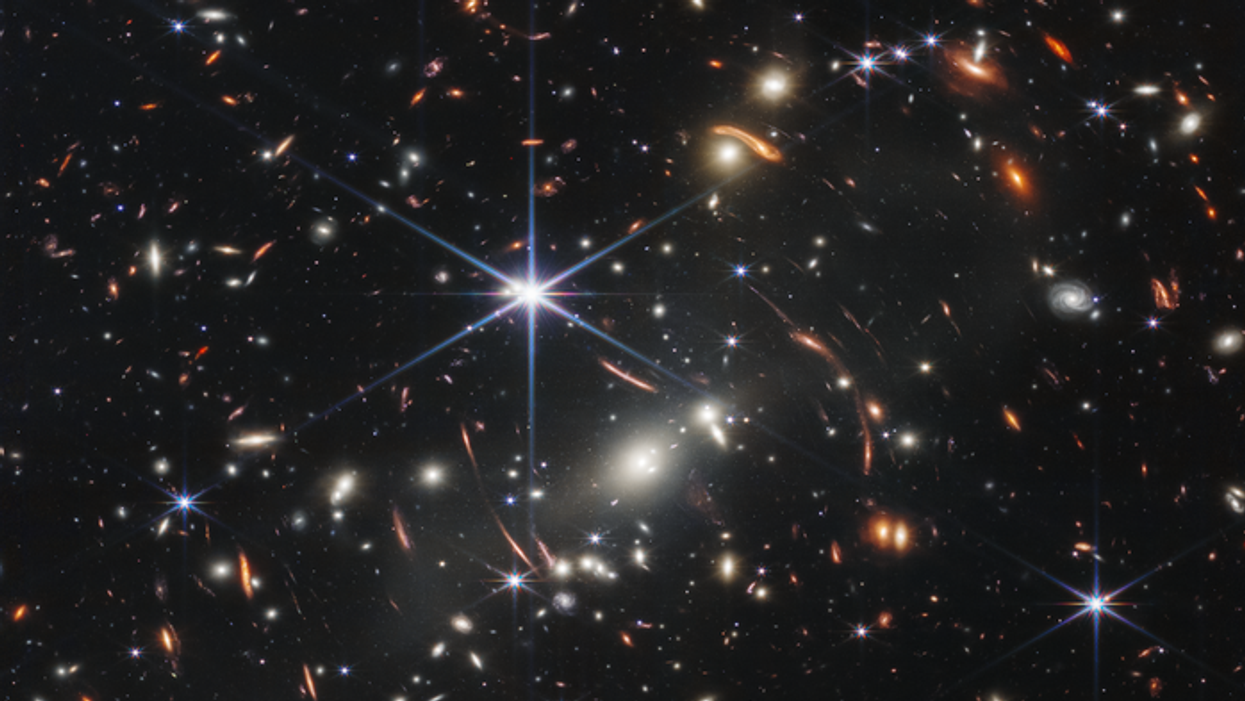NASA's James Webb Telescope Just Revealed The Best Space Photo Ever & Here's What It Shows
We are teeny-tiny specks in the universe. 🤯

Webb's First Deep Field as taken by the James Webb Space Telescope.
If you want to feel small, just sit for a moment and really soak in the new photo from NASA and the James Webb Space Telescope.
Scientists recently brought the world's new super-powerful telescope online, and on Monday night, they shared its very first full-colour photo of the universe.
And just... wow.
\u201cIt's here\u2013the deepest, sharpest infrared view of the universe to date: Webb's First Deep Field.\n\nPreviewed by @POTUS on July 11, it shows galaxies once invisible to us. The full set of @NASAWebb's first full-color images & data will be revealed July 12: https://t.co/63zxpNDi4I\u201d— NASA (@NASA) 1657578190
The image shows a universe exploding with light — and not in a Star Wars smattering of stars, either. The Webb photo is filled with distant galaxies, white-hot stars and vibrant nebulas.
NASA is calling the photo Webb's First Deep Field, and it captures a whole cluster of galaxies, including many that humans have never seen before.
"Many of the extremely distant galaxies in this field don't yet have names, nor are they formally catalogued," NASA's Space Telescope Science Institute tweeted. "This is the first time we've detected them!"
And the wildest part? This isn't a pic of our entire sky. Instead, the telescope captured this cluster of galaxies by looking at a "patch of sky approximately the size of a grain of sand held at arm's length by someone on the ground," NASA says.
In other words, space is mind-blowingly big.
NASA says it took the photo using Webb's special Near-Infrared Camera. While the telescope is our most cutting-edge to date, it actually took 12.5 hours to capture this single photo — much like an old-time camera from 1900.
The image itself is also pretty retro because light takes a long time to travel from a distant star to Earth's telescopes. In this case, NASA says the Webb snapshot shows those distant galaxies as they would've appeared 4.6 billion years ago.
The photo was released Monday as a teaser for a bigger event Tuesday when NASA dropped the rest of its camera roll.
The new pics included several more incredible discoveries, including the first-ever evidence of water and clouds around a distant planet.
\u201cClouds on another world. @NASAWebb captured the signature of water on giant gas planet WASP 96-b, which orbits a star 1,150 light-years away. For the first time, we've detected evidence of clouds in this exoplanet's atmosphere: https://t.co/63zxpNDi4I #UnfoldTheUniverse\u201d— NASA (@NASA) 1657637253
NASA also revealed a stunning pic of a dying star, which looks like something you might see on a deep-sea dive or under a powerful microscope.
\u201cPut a ring on it! \ud83d\udc8d\n \nCompare views of the Southern Ring nebula and its pair of stars by Webb\u2019s NIRCam (L) & MIRI (R) instruments. The dimmer, dying star is expelling gas and dust that Webb sees through in unprecedented detail: https://t.co/tlougFWg8B #UnfoldTheUniverse\u201d— NASA Webb Telescope (@NASA Webb Telescope) 1657637985
This is only just a taste of what we'll get to see in the years ahead, according to Chris Hadfield, former commander of the International Space Station.
"It's going to be able to see atmospheres around planets that are orbiting other stars," he told Narcity in an interview last month. "We may show that there is life on a planet orbiting (another star)."
The James Webb Space Telescope launched late last year and recently came online as a new and improved replacement for the Hubble Space Telescope.
That means we're only just getting started with this thing, and there will be many more incredible photos to come.
In the meantime, I'm making this one the new lock screen on my phone.
So cool!
- Chris Hadfield Can't Wait For The New Moon Missions & He Says It's ... ›
- NASA Mars Mission Jobs Are Available & You Don't Need A PhD ... ›
- NASA Offering $500K For Ideas On How To Send Fresh Food To ... ›
- Canada's Part Of The Webb Telescope Confirmed Water In An Exoplanet's Atmosphere - Narcity ›
- Jupiter Will Be The Brightest It's Been In 59 Years Tonight & You Can See It Across Canada - Narcity ›
- NASA Picked A Canadian For Its Historic Moon Mission & The Reason Will Fill You With Pride - Narcity ›
